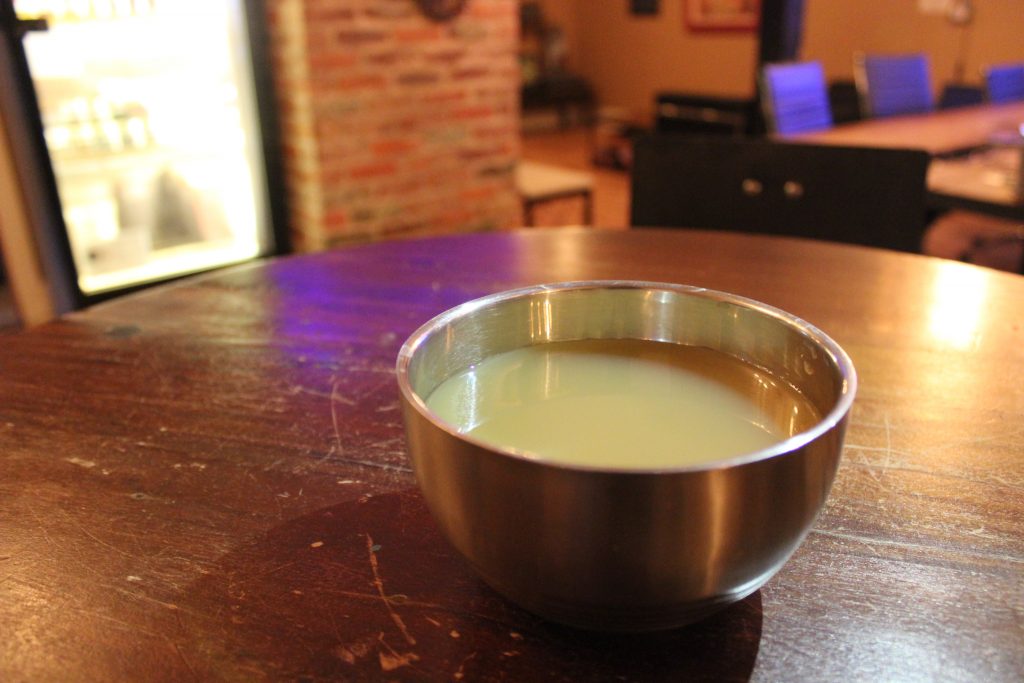Pictured Above: Kratom is a leaf brewed into a tea and typically mixed with flavored syrups.
Molly Ryan | The Crow’s Nest
By Molly Ryan
When I was introduced to kava and kratom, I thought they were just some snake oil drinks that hippies sold to their curious clientele.
However, I soon began to realize that these hippies had some insight that I was lacking at the time — this stuff actually worked.
Kava comes from a root native to Polynesia that is used as a social drink in native cultures, similar to alcohol’s use in Western societies. The drink has a calming effect that is regularly used to treat stress, restlessness and pain.

Molly Ryan | The Crow’s Nest
Kratom starts as a leaf and is finely ground into a powder. There are multiple “strains” depending on the type of leaf it comes from; the key three are green with a euphoric/social effect, white that helps with focus and red that is used for relaxation and pain relief.
At the bars, both substances are primarily served as drinks; with kava served in a small, bowl-shaped cup called a “shell” and kratom brewed as a tea.
I personally tend to stick to kratom since the taste is easy to mask with syrups – as opposed to kava’s potent and earthy taste (that I personally find vile).
Living in St. Petersburg has made kratom and kava readily available considering there are over a dozen bars and distributors in the area, not including the smoke shops that typically sell them wholesale.
But misconceptions come from both its users and the skeptics.
Like most mood-altering substances, both must be consumed in moderation.
According to WebMD, “Many cases of liver damage and even some deaths have been traced to kava use. As a result, kava has been banned from the market in Europe and Canada.”
But, “despite health concerns, kava has not been taken off the U.S. market.”
Valid concerns are raised; however, while we don’t yet know if kava is less toxic than alcohol, it is typically consumed in smaller quantities.
The same stigma surrounds kratom, as it stimulates some of the same receptors that are triggered when taking opioids.
As the opioid epidemic sweeps across America, leaving an especially deep scar in Florida, kratom has been widely used by those recovering from drug dependency.
“One of the reasons it’s even legal in the state of Florida is because there is such a large population of opiate addicts as well as those recovering from an opioid addiction,” Nathan Galipault, a 21-year-old St. Petersburg College (SPC) student, said.
“I see it as a good thing to have a healthier and productive alternative for people who are recovering from addiction, and not just for opiates,” Galipault said. “It’s important for it to be legal so it can be sold by respected establishments with correct oversight in serving it and selling it to people. It wouldn’t be legal if people didn’t see some validity in it.”
But for the most part, people use it as a relaxant and/or a study aid.
“For me, it’s definitely helped me with anxiety issues as well,” fellow SPC student Tevin Phatsavong said. “It helps me push through my lack of motivation and my social anxiety that I experience. It also helps me avoid drugs and alcohol, since they’re so readily accessible and accepted by people in college.”
As a college student and a recovering caffeine addict, I have found that a small glass of kratom’s white tea does the job when I’m not feeling motivated.
Most days, as I have slowly cut caffeine out of my diet, I feel no need to even brew a cup of coffee in the morning.
“A lot of people get addicted to a lot of different things without even realizing it… It’s definitely possible to become dependent on kratom, but the most it entails is just a headache if you choose not to have it that day,” Galipault added.“If you’re going to be ‘dependent’ on something, might as well have it be something that makes you productive and isn’t quite as harmful (as other substances) …”
Anything can be abused in excess, and it’s especially easy to feel uneasy by kava and kratom’s ambiguity.
However, for me and the people I have met in the community, the substances have done much better for our lives than harm.
“There are a lot of misconceptions about kratom and kava… because I think that there’s an industry that sees it as a threat to their profit,” local filmmaker and avid kratom drinker Jacob Whitney said.
“There are legitimate health concerns about it, there’s a lot of things about it that haven’t been studied yet…” Whitney added. “I’ve seen kratom positively affect people and I’ve seen kratom negatively affect people, it really, like anything else, boils down to the individual and their ability to moderate themselves or not.”
Right now, it’s too early to tell if this obscure leaf water is potentially harming me. But what I know is that it has kept me from clinging to more harmful vices.




Withdrawal from Kratom can be very uncomfortable for those who overuse it. It’s an incredible plant, but should be consumed in moderation.
I have used kratom to quit the use of dangerous opioids. I suggest that people should get complete information about this plant before buy kratom online.
I would most certainly be spending $100 per day on Oxycontin… I still can’t believe I spend $100 a month on Kratom instead, and I’m satisfied. I’m okay now, finally, I’m better. Kratom saved my life. I over do it sometimes and it’s a struggle. But it so much better that overdoing Oxy.
Thank you for sharing such a valuable post about kava and kratom. This is very useful for me.